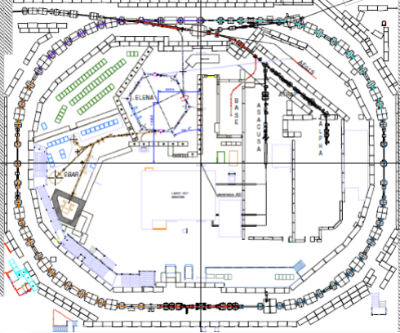ELENA
From 2015/2016, a new facility called ELENA (Extra Low Energy Antiproton Ring) shall enable all experiments working at the AD to get lower energy, higher quality and more abundant antiproton beams, enabling the production of larger quantities of antihydrogen. ELENA shall further decelerate the antiprotons injected from the AD at 5.3 MeV to 100 keV, with a beam population of 107cooled antiprotons.
Since the publication of the technical design report the design team have been able to focus on the optimization of the overall ring. Studies into the beam dynamics, optics and overall quality of the beam are currently being carried out by the QUASAR group.

Schematic layout of the AD hall with ELENA and experimental areas
Current areas of research:
-
Optimization of the ELENA optics design: beam physics studies towards the optimization of the current optics layout of the machine in order to improve the beam quality. The goal is to end up with an optimized optics lattice of the ELENA ring (using the accelerator code MAD-X), as well as to perform a full 3D electromagnetic model of all the machine elements. A full 3D model of the machine, linking the optics MAD-X model with the full electromagnetic map of the components will allow a precise evaluation of the dynamic aperture and ring acceptance.
-
Advanced beam dynamics simulations to determine the impact of different effects on the beam quality, such as space charge effects and intra beam scattering, impact from fringe field effects on beam stability and life time in the ring, as well as on the beam quality in the different beam transfer lines. Simulations take into account possible imperfections of the machine and investigate methods to counteract them.
-
Investigate methods for further beam quality optimization for all planned experiments. The 3D model of the machine will allow the detailed investigation of key elements and transfer lines of the machine, such as cooler merging sections and possible locations for the integration of in-ring collision experiments. The goal is to improve beam transmission and control losses, as well as test the feasibility of novel systems for beam injection and extraction in order to further improve the beam quality for the experiments.
Selected publications and further information:
O. Karamyshev, D. Newton, C.P. Welsch, 'Optimization of Low Energy Electrostatic Beam Lines', Proceedings of IPAC2014, (TUPRO071)
A. Papash, A. Smirnov and C.P. Welsch, 'Nonlinear and long-term beam dynamics in low energy storage rings', Phys. Rev. ST Accel. Beams 16, 060101 (2013) (e060101)
ELENA home page